Developing the UK's shorthanded offshore racing talent
It has been more than a decade in coming, but finally the UK is to have a shorthanded offshore training school, hopefully one day able to match France’s mighty and long established Pôle France Finistère Course au Large training centre in Port la Foret.
Last week Artemis (Investment Managers, rather than Torbjorn Tornqvist’s AC/TP52/RC44 team) announced that they are to focus their sailing sponsorship on developing new talent on the shorthanded offshore side of the sport. This follows the success of Ellen MacArthur, and those who have followed after her, in events such as the Vendee Globe, which has proved to be one of the most headline-grabbing areas within sailing. The new project is being set up by OC, who run the singlehanded transatlantic race bearing the Artemis name and have more recently taken over the management of the Edinburgh-based investment house’s IMOCA 60 campaign as well.
The Artemis Offshore Academy is a slight misnomer, as it will focus entirely on shorthanded and particularly singlehanded offshore racing. Unlike the French schools - which typically have a base in one location, usually where there is a gathering of boats, Port la Foret being the classic example – the AOA is to be of no fixed abode at this stage, with the plan for initial training to take place out of the Weymouth & Portland Sailing Academy and then moving down to La Grande Motte in the south of France, where Franck Citeau, ex-Olympic Tornado sailor turned coach, has a training school. This is where Artemis’ Open 60 turned Figaro skipper Jonny Malbon spent last winter training.
This is the initial plan, says OC’s Charles Darbyshire, who is setting up the Academy. “We are going to take it slowly slowly, to make sure we do deliver on what people have been wanting and asking for. It has certainly been on our list for a while, even though we have been lucky that the people we have worked with have got some great results without that in place. Ellen [MacArthur] didn’t have that formal school, although she did a significant part of what we are trying to do, in that she did some Figaro sailing, etc.
“And Sam [Davies] did the [Figaro] circuit. What Sam’s case shows to us is that our goal is not to be the greatest Figaro sailors in the world, but to create great solo sailors. The Figaro is a means to an end. An overall result in the Figaro class may not be the measure of success; people moving on and doing other great stuff will be the measure of success. Sam’s best result in the Figaro was her rookie year, but it just teaches you so much, it is hard to ignore.”
Saying this, they are under no illusion: the Artemis Offshore Academy is solely about creating winners as much as the RYA’s program for the Skandia Team GBR Olympic team is.
In addition to having a movable training camp, the AOA will also differ from the French schools in that it will draw on coaching talent from both sides of the Channel. “If it is specifically about boat handling on Figaros, then obviously it makes sense to go to France and pick up one of their coaches,” continues Darbyshire. “But we have also got quite a few specialists in the UK who have coached Olympic sailors on the performance elements of sailing, or being an athlete, that we probably do do better than the French. So we’ll pick and choose between them.” Significantly, Darbyshire points out, this will not only help nurture the UK’s shorthanded sailing talent, but will enable the UK to develop its own shorthanded offshore racing coaches.
While Derbyshire is putting the pieces in place, ultimately the structure of the Artemis Offshore Academy will comprise an Advisory Board, to include former RYA CEO Rod Carr (a principle architect in Skandia Team GBR Olympic success), The Times’ former sailing correspondent Ed Gorman, ex-Mini Transat winner and Figaro sailor Gilles Chiorri (now with OC running the Extreme Sailing Series), OC’s Mark Turner, and two current IMOCA 60 skippers, as yet to be named. The Advisory Board is expected to meet three or four times a year.
Day to day running of the AOA will be handled by a Performance Director, still to be appointed. “The Performance Director won’t necessarily be the best coach or the best solo sailor, they’ll just be used to running programs,” states Darbyshire.
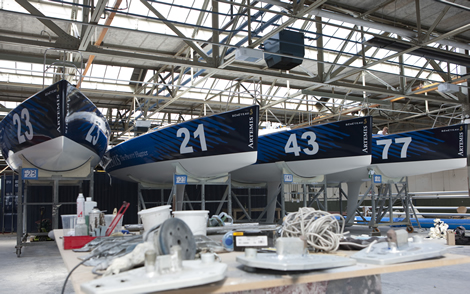
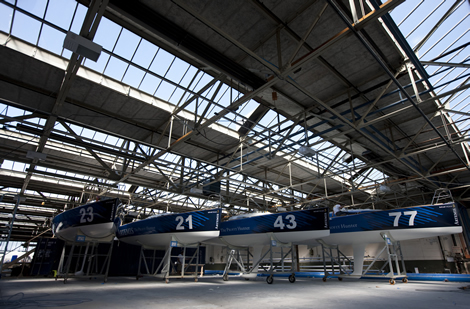
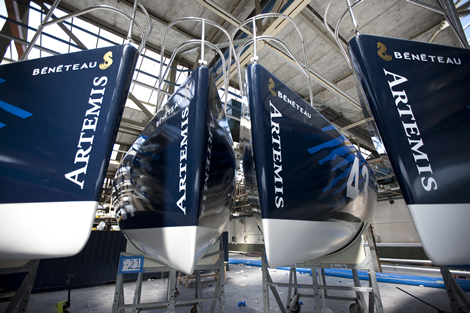
In terms of hardware, over the last weeks OC have been scouring France and have bought four secondhand Figaro 2s which they have since refitted in Cowes and rebranded in Artemis blue. They also have the Artemis 2 IMOCA 60 (seriously for sale) and have acquired a Pogo 2 Series class Mini, Ollie Bond’s steed in last year’s Mini Transat.
Those attending the Artemis Offshore Academy will fall into three groups. The ‘development squad’ will number 8-12 and will be a mix of up and coming sailors invited to join and those who gain entry through an application process. This application process will open on the Monday of Cowes Week. The final squad will be decided after some selection events which will not only test sailing ability but “whether they can work within a squad, do they have an aptitude for solo sailing, are they good performance sailors, have they achieved on the race course in some other discipline, like dinghys, keelboats or big boats, etc.” says Darbyshire.
There is obviously some kind of fit with the RYA’s British Keelboat Academy, run by the UKSA, which like OC is also based in Cowes, but Derbyshire says the AOA is probably catering for an older group of sailors – typically 24-30, although this is by no means set in stone. “They have a very different thing in that they are looking for sailors aged 16-24. So I think the tie up will be that we will be one of the options for their sailors to move out of the keelboat squad to something else. They want to create good sailors who can sail Volvos, AC, TP52s, etc, but they do a reasonable amount of offshore sailing as well, so there are a lot of people getting good experience offshore in a fully crewed world and some of those people would transfer quite happily to be solo sailors.”
Channels of communication have been opened with the British Keelboat Academy who are to provide crew for the Artemis corporate sailing during Cowes Week.
In addition to the development squad, the likes of Katie Miller and Nigel King, who already have Figaro campaigns and boats, can join the Artemis Offshore Academy as ‘associate sailors’. It is this area which Darbyshire hopes will develop over forthcoming years with the ultimate aim that all four of their Figaros will have their own sponsors and branding, Artemis effectively providing the seed funding.
“We are a way away from that,” says Darbyshire. “Port la Foret works like that - you become associated with Port la Foret and you bring your own campaign to that program, but it is very tough to do that in the UK, because there aren’t the boats and there isn’t that level of sponsor at the moment. In France it is not easy, but it is fairly well established that you can get local sponsorship for maybe 100,000 Euros for your Figaro season. That doesn’t exist in the UK. It will be our job in the UK to create that market and help provide a return to those kind of sponsors.”
This will be no mean feat given that the majority of Figaro racing takes place in France. However with this new British initiative on the Figaro class, it may mean the organisers of the Solitaire can be coaxed to bring the race back to the UK in the future. There are also obviously a number of domestic singlehanded and doublehanded events, notably those organised by the Royal Southampton Yacht Club, that the AOA squad could take part in, but one wonders if another Figaro circuit event could be established in the UK.
“Just like there are loads of little Figaro races around the north coast of France and Brittany – sure, why wouldn’t we have a Portland-Falmouth-Jersey-Portland race say, and invite a load of French sailors to take part in that? I think now the UK has real commitment to the class, the class will commit to the UK a bit,” states Darbyshire.
And finally, before we get distracted again, the third genre attending the Artemis Offshore Academy will be ‘ambassador sailors’, established names in solo offshore racing, not just the Alex Thomsons, Mike Goldings and Dee Caffaris of this world, who can use the AOA for pre-race training, just as happens with the Breton-based Open 60 fleet prior to major IMOCA events, but also the top crop of UK Class 40 sailors.
“The other thing is - it need not always be about solo sailing,” states Darbyshire. “Although ultimately we want to create good solo sailors, it is about ‘shorthanded sailing’. So not only do we need to create the solo skipper person, but it would be nice to have a few people that don’t have the last 5% to take them offshore solo, but would love to do some two handed stuff and would be very good doublehanded sailors.”
In terms of timing the selection process to establish the development squad will take place over the end of August and early September. Training is scheduled to get underway in Weymouth and Portland from mid-September until late November before the show moves to La Grande Motte, firing up once again in the new year.
The training schedule will presumably ressemble that of the Port la Foret school, that after years of development is very well refined. Training will include much time on the water with a coach with a megaphone providing instruction as well as visits from specialists in sails, rig set-up as well as race craft. But there will be a lot of classroom-based instruction on the multitude of disciplines necessary for solo offshore racing - from weather to boat on boat tactics to sleep deprivation and hopefully tuition on how to fix things from engines and generators to electrics and electronics, sails, rigging, boat building, etc.
“What the French do currently is a week on and a week off,” says Derbyshire. “It is not exactly how it works, but we’ll do a similar thing. We want our squad members to take part in the training but they have to have the ability to go and earn money elsewhere, to go and look for sponsors and just generally be out there getting their own program together.”
But ultimately the aim is not just to mimic the Port la Foret school – it is to improve on it. “In lots of ways it is imperfect because it has got a large roster of very good sailors, so anyone new to that can be a bit overawed and find themselves actually quite low down the ladder. So by starting afresh and working with La Grande Motte, you do feel like you have a proper seat at the table and there won’t be a million megastar sailors you are competing for training with,” says Darbyshire.
While the principle goal of those attending the Artemis Offshore Academy is training and development, there is an ultimate prize. Artemis this year have committed to backing Jonny Malbon in his Figaro campaign, but for 2011 this campaign will come up for grabs, to be taken over by the brightest light from the 2010 crop of AOA development squad sailors. According to Darbyshire this decision will be made in March 2011.
While Artemis will only fund one full campaign on the Figaro circuit, Darbyshire doesn’t discount all five of their Figaro 2s (the four training boats, plus Malbon’s) taking part in some races in France such as next season’s Tour de Bretagne.
The Artemis Pogo 2 will also be available for a Mini campaign should one of the sailors come along with a suitable budget – the advantage being that they wouldn’t have to bear the high initial capital cost of buying the boat.
Prior to all this the Artemis Figaros will be corporate sailing during Cowes Week while the Artemis IMOCA 60 will take part in the annual Artemis Challenge for the IMOCA 60s around the Isle of Wight. The 60 is then scheduled to compete in the RORC’s Seven Stars Round Britain Race, with a crew yet to be announced, but probably a mix of AOA possibles and some more experienced IMOCA 60 sailors.
The Artemis Offshore Academy is the most welcome news this side of the sport in the UK has had in recent years. This could be the step that gains Britain its first Vendee Globe winner in years to come.
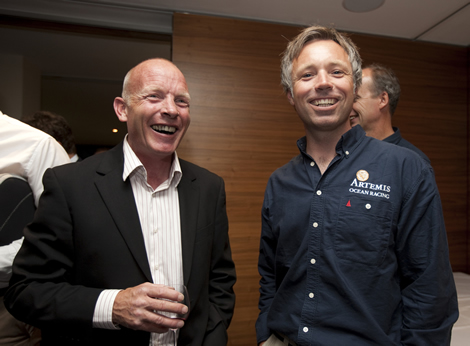
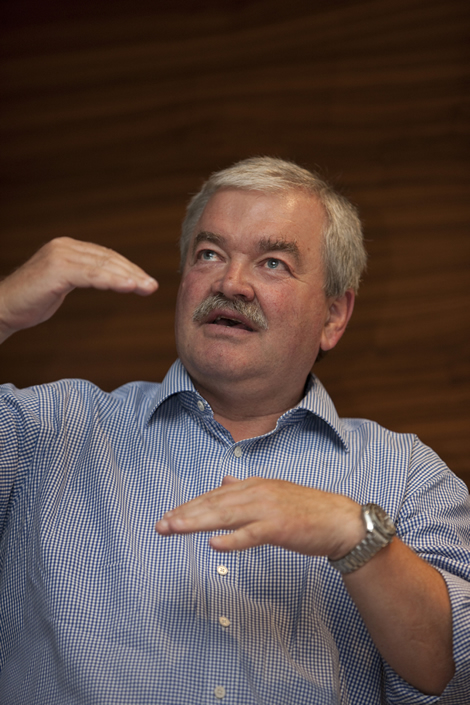
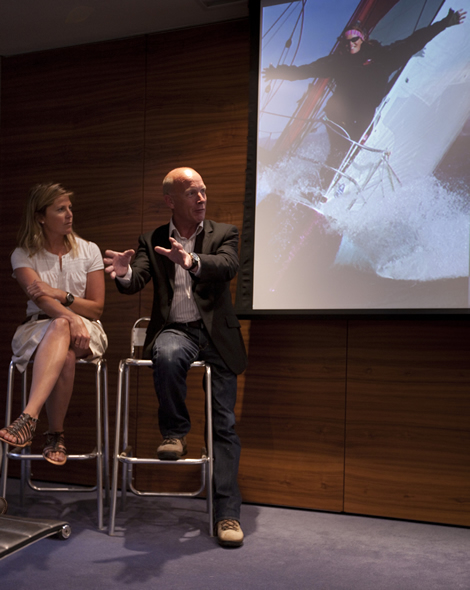













Latest Comments
Add a comment - Members log in